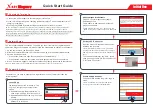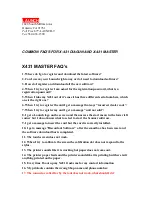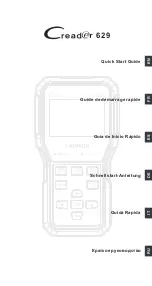
6"
Distance from Eye
Screwd
river Vie
wed Siz
e
18
Theory of Operation
TARGET ACQUISTION
When we begin a new alignment the program has no idea where the targets are located. The software turns
on the cameras and goes into a “search mode”, looking throughout the cameras’ field of view for any targets.
We see this on the screen in the form of 4 red targets away from the wheels. Since the software knows what
a target looks like, when it sees an object that may be a target it applies what is called a “fit algorithm” – how
closely does that object match what it knows to be a target. In this way, objects that are not targets (such
as reflective lamps on the vehicle) are ignored. As each target is found and fitted (or acquired) it turns blue
on the screen and appears attached to the wheel. When a target is acquired the software “hones in” on that
region of the camera view ignoring activity in the background. This allows the system to be more responsive
to changes in target position.
3D VISION THEORY
From the previous discussions of the components of the 3D Aligner we have a basic understanding of how
the hardware system functions. But how does the software take these camera images of target dots and inter-
pret them as wheel alignment angles?
PERSPECTIVE
One of the things the 3D Aligner must determine is how far away each target is from the cameras at any given
moment. As everyone knows, objects appear to get smaller as the move farther away, even though their
actual size remains the same. If you look at a screwdriver 2 feet away from you it looks much larger than it
does at 20 feet away. This effect is called
perspective
. Artists create the illusion of depth and distance in two-
dimensional drawings using this technique.
In the example above, assume that the screwdriver is 6 inches long. If you had a way to “measure” the exact
size of the screwdriver your eye sees at some distance away, through the application of high school level
mathematics you can determine how far the screwdriver is from your eye. On the following page there is a
more detailed explanation of the mathematical principles.
In this example, the camera is at a fixed point in space. All fixed camera lenses have a fixed focal point. The
distance from the camera to the focal point is a known value F, created by the designers of the lens. The
size of the pen is a known value P, created by the designers of the pen. The perceived size of the pen is
measured by our “software” at the focal point and becomes a known value A. The goal of this exercise is to
determine the distance D from the camera to the pen.
Summary of Contents for UHR Ultra
Page 1: ...Service Manual Ultra UHR Ultra and V3400 WHEEL ALIGNER May 2014 ...
Page 13: ...11 AC DC POWER DISTRIBUTION ...
Page 14: ...12 AC DC POWER DISTRIBUTION ...
Page 16: ...14 Theory of Operation Figure 2 Top Field of View Figure1 Side Field of View ...
Page 19: ...17 Theory of Operation Configuration using single pole wheel clamp ...
Page 46: ...44 NOTES ...
Page 67: ...65 Diagnostics ...
Page 68: ...66 NOTES ...
Page 83: ......
Page 84: ...05 07 2014 2014 Impreso en U S A 309 Exchange Avenue Conway AR 72032 TEEWA546P4 Rev C ...
















































